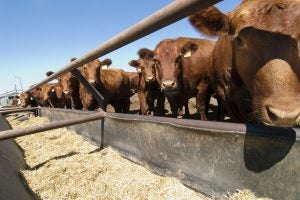Should or could the cattle industry follow their hog and poultry relatives into an even more intensive system of confinement?
When Mother Nature drops the hammer on a part of the world, or the government claws back some federal grazing lands, or a greedy neighbor breaks a handshake deal because he got a better offer, cow/calf producers can find themselves without pasture land.
The question then crops up: What to do?
As Bob Dylan sang, “The times they are a changing.” Sometimes cattle folk must rein their mount in a new direction.
How possible is a new direction?
Karl Hoppe, North Dakota State University Extension Livestock Specialist, has an idea of where that direction might lead. “Cows don’t have to eat grass. If we’ve invested time and effort into a cow herd, we can certainly feed them in a pen. We’ve done it here at Carrington for 40 years.”
The Carrington Research Extension Center at NDSU conducts research and educational programs to enhance the productivity, competitiveness, and diversity of agriculture in central North Dakota. It has been home to a cow/calf herd living in drylot conditions for decades.
Hoppe believes cows can move from the pasture to the pen. At least temporarily if desired. Maybe even more long term.
That concept forces a new question entirely: Should or could the cattle industry follow their hog and poultry relatives into an even more intensive system of confinement?
Hoppe says this has already been happening for decades, at least to a degree. “We actually went into mega sized grain-based cattle feeding back in the ’70s — 50 years ago. So, people ask about conglomeration of the cattle industry — that was done long before the swine industry ever got large.”
He explains farm-based operators switched to large yards throughout the western Corn Belt of Nebraska, Kansas, Texas, and Oklahoma because of the weather. Plus, the technology of the weigh scale and mixer wagon allowed more precise feeding of the animals.
“We’ve been there for 50 years and this is how it shook out,” he said. “We have huge lots with 10 to 20 thousand head. Right beside lots with 50 to 100 animals.”
But a feedyard is generally not a cow yard.
Remember, “Cows don’t have to eat grass.”
Examining the facts
It’s always sensible to be open to facts. Some positives (not all) for moving the herd from the pasture to the pen.
- Cows and calves can be more closely monitored for sickness.
- Grains and crop residues with lower cash value such as wheat middlings, potato processing products, wet and dry beet pulp and tailings, and screenings can be marketed as better value through cattle.
- Reproductive technologies such as artificial insemination and estrus synchronization could be used more efficiently and effectively.
- Weaning of calves should be less stressful and since they will be bunk broke, will go on feed quicker with a faster adaptation to rations.
- Record keeping is easier with daily observation of individual animals.
- Weighing, tagging, vaccinating, and treating is less strenuous in a confined area.
- Marketing of cows and calves is more flexible as prospective buyers can easily inspect animals when desired.
Now some negatives (not all) for confining the herd.
- Feed is a huge cost for drylot herds and might easily be double.
- Pens may become a hot, crowded, dusty, muddy, fly infested environment.
- Infrastructure deteriorates and requires constant upkeep.
- Cattle become bored and develop bad habits like chewing fences and eating dirt.
- More labor is needed to manage confined cattle.
- Manure is constant and eventually needs to find a new home.
- Neighbors may think it smells and complain.
- Confined cows and calves produce more health and veterinary issues. Think COVID-19 of the animal kingdom.

Don’t rely on stale thinking
Whichever direction the table is viewed to be tilting, Hoppe encourages out-of-the-box thinking. He says, at Carrington, the focus was always, “What do I do if I don’t have pasture?” To follow this premise, the calves were always raised with the mothers in the feedyard all summer. Weaned, put in a different pen, and the mothers fed throughout the fall. But Carrington was originally an irrigation station. They grazed the animals under irrigation, but grass was soon too plentiful and became trampled and useless. So, they changed, harvested the forage, and took it to the pens.
“Maybe it’s time to revisit that. We haul manure back out to the field so there is a back and forth going on,” he said.
Hoppe says there has been work in Nebraska employing more radical thinking: weaning extremely early, at 2 or 3 months of age. Or calving at odd times of year.
“Why do we calve in the spring? Why not September or October?,” he asked. “It doesn’t make any difference if we’re not matching our feed to the resources on the pasture. We could calve whenever we think the market for the offspring will be better. There are different perspectives out there on how to manage a pen situation which should be talked about.”
The bottom line
He adds the price of pork is extremely low compared to beef, and if competitive, cattlemen would be pursuing confinement to a larger degree. “Let me put it this way — I think we will maintain the grass-based cow herd as long as it is available for the cow. If our demand for beef cattle gets higher than what the grass state system will allow, then we could go into confinement and raise cattle that way.”
But in a pinch, when Mother Nature swings her hammer, just like in Iowa where monoslope and hoop barns dominate the landscape due to mud and the lack of reasonably priced pasture, confinement of the herd can work.
“Again, I don’t see it happening with our beef cow herds until the demand really increases,” Hoppe said. “And if that happens, other countries are going to get in there and want to start producing more beef for the world. But remember, cows don’t have to eat grass.”
Bruce Derksen has worked in Western Canada’s ranching and feedlot industry for over 30 years. He writes about present-day agriculture, hoping to give producers as much up-to-date information and insights about the future of the industry as possible.



